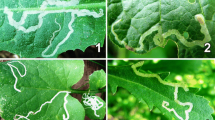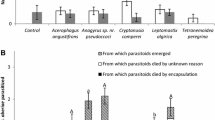Abstract
Pachycerus cordiger Germar (Curculionidae: Cleonini) is a potential agent for the biological control ofHeliotropium europaeum L. (Boraginaceae) in Australia. Adults feed on the leaves and larvae feed on the main roots of the weed within an earthen cell. These is one generation per year. Adults overwinter in the cells before emerging in late spring when they begin to feed, mate and oviposit on their host plants from late May until late July. Seven Boraginaceae and 31 economically important crop species were tested using adults and 1st instar larvae.P. cordiger was found to be specific to the Boraginaceae. Field observations strongly suggested that the weevil is restricted to summer-annualHeliotropium species. A widespread egg parasite,Caenocrepis? bothynoderi Gromakov [Hymenoptera: Pteromalidae], caused up to 18% mortality.
Résumé
Le charançonPachycerus cordiger Germar [Curculionidae: Cleonini] est prometteur pour lutter contre la mauvaise herbeHeliotropium europaeum L. (Boraginaceae) en Australia. L'adulte se nourrit des feuilles et la larve construit une cellule de terre autour d'une racine principale dont elle se nourrit. Il n'y a qu'une seule génération par an. Les nouveaux adultes passent l'hiver toujours dans leurs cellules avant de sortir au printemps, saison à partir de laquelle ils commencent à se nourrir, à s'accoupler et à pondre sur leurs plantes hôtes de Mai jusqu'à la fin de Juillet. Des adultes et des larves du 1er stade ont été testés sur 7 espèces de Boraginacées et 31 des plus importantes espèces cultivées.P. cordiger s'est montré spécifique des Boraginacées. Selon les observations sur le terrain, ce charançon est probablement limité aux espèces annuelles d'Heliotropium de l'été. Un parasite des œufs,Caenocrepis ?bothynoderi Gromakov [Hymenoptera: Pteromalidae] est très répandu et peut occasionner jusqu'à 18% de mortalité.
Similar content being viewed by others
References
Aleeva, M. — 1953. Data on the biology of weevils [Curculionidae] injurious to sugar beet in Kazakhstan. —Ent. Obozr., 33, 103–108.
Balachowsky, A. S. — 1963. Entomologie appliquée à l'agriculture. Tome I. Coléoptères, 2e vol. —Masson et Cie, Paris, 567–1391.
Brummitt, R. K. — 1972.Heliotropium L. In: Flora Europaea. Vol. 3.Diapensiaceae toMyoporaceae (T. G. Tutin et al., eds). —Cambridge Univ. Press, Cambridge, 1–370.
Davatchi, A. & Kheyri M. — 1964. Les curculionides de la betterave à sucre en Iran. —Univ. de Téhéran, Téhéran, 1–10.
Dickmann, L. — 1983. Beiträge zur Insektenfauna der DDR: Coleoptera — Curculionidae [Tanymecinae, Leptopiinae, Cleoninae, Tanyrhynchinae, Cossoninae, Raymondionyminae, Bagoinae, Tanysphyrinae]. —Beitr. Entomol., 33, 257–381.
Everist, S. L. — 1974. Poisonous plants of Australia. —Angus & Robertson Publ., Sydney, 1–684.
Hartley, W. — 1979. A checklist of economic plants in Australia. —Commonw. Sci. Indust. Res. Organ., Melbourne, 1–214.
Hoffmann, A. — 1950. Faune de France. 52. Coléoptères curculionides (première partie). —Paul LeChevalier, Paris, 1–486.
Huber, J. T. — 1979. A method for observing and rearing the rootfeeding larvae ofLongitarsus albineus (Foudras) [Col.: Chrysomelidae]. —Mitt. Schweiz. Entomol. Ges., 52, 431–433.
Huber, J. T. — 1981. Observations on the heliotrope flea beetle,Longitarsus albineus [Col.: Chrysomelidae] with tests of its host specificity. —Entomophaga, 26, 265–273.
Lohse, G. A. — 1983. UnterfamilieCleoninae. In: Die Käfer Mitteleuropas. Band 11 (Freude, H. et al., eds). —Goecke & Evers Verlag, Krefeld, 1–342.
Meadly, G. R. W. — 1968. Common heliotrope [Heliotropium europaeum L.]. —J. Dep. Agric., West Aust., 9, 121–124.
Moore, C. W. E. — 1956. Observations on the autecology ofHeliotropium europaeum L. in New South Wales and Victoria. —C.S.I.R.O. Aust. Div. Plant Ind. Tech. Pap., 7, 1–12.
Orchard, H. E. — 1949. Common heliotrope or potato weed (H. europaeum L.) and its distribution in South Australia. —J. Dept. Agric., South Aust., 52, 437.
Reitter, E. — 1916. Fauna Germanica. Die Käfer des Deutschen Reiches — V Band, Stuttgart, 1916.
Riedl, H. — 1967.Boraginaceae. In: Flora des Iranischen Hochlandes und der unrahmenden Gebirge (K. Rechinger, ed.). —Akad. Druck- u. Verlagsanst., Graz, 1–281.
Solari, F. — 1950. IPachycerus europei ed un nuovo genere di Cleonini [Col.: Curc.]. —Boll. Ent. Soc. Ital., 80, 50–54.
Ter-Minasyan, M. E. — 1978. Weevils of the subfamilyCleoninae in the fauna of the USSR. Tribe Lixini. —Amerind Publ. Co. Pvt. Ltd., New Dehli, 1–166.
Wilson, F. — 1960. A review of the biological control of insects and weeds in Australia and Australian New Guinea. —Commonw. Inst. Biol. Contr. Tech. Comm., 1, 1–102.
Author information
Authors and Affiliations
Rights and permissions
About this article
Cite this article
Huber, J.T., Vayssieres, J.F. Life cycle and host specificity of the heliotrope weevil,Pachycerus cordiger (=Madidus auct.) [Col.: Curculionidae]. Entomophaga 35, 475–484 (1990). https://doi.org/10.1007/BF02375273
Received:
Accepted:
Issue Date:
DOI: https://doi.org/10.1007/BF02375273
Key-Words
- Life cycle
- Host specificity
- Pachycerus cordiger
- Coleoptera
- Curculionidae
- Heliotropeum europeaeum
- Boraginaceae
- Biological control




